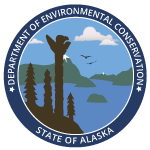Preventing Spills During Flood Events
Flooding can cause spills of oil or hazardous substances to your property. Taking steps now can help prevent spills and protect your home, health, and the environment.
How can flooding cause a spill on my property?
- Floodwaters can move unanchored tanks or cause them to tip.
- Water can enter tanks through vents or loose fittings, pushing fuel out.
- Tank supports may fail under flood pressure or eroded soil.
- Floating debris can strike tanks or piping, causing damage and leaks.
- Containers of hazardous substances can tip, float, or break open.
What should I do before a flood?
- Walk through your property to identify substances that could be spilled by flooding. Some examples include fuel tanks, barrels of used oil, gas cans, paints, cleaning supplies, and solvents. Pay special attention to items stored in your yard or lower levels of your home that could float away or spill.
- Collect household chemicals from cabinets, crawlspaces, garages, sheds, etc. and store them in sealed, waterproof bins in an elevated area.
- Move small containers, buckets, drums, or tanks of oil or hazardous substances to a secure, elevated location.
If you have a fuel tank
- Inspect the tank and components to ensure that all seals are watertight. Check the fill pipe and cap, sight glass, vent pipe, and fuel filter. Replace any worn or damaged parts. Measure the current fuel level in the tank and take pictures to document the condition before flooding.
- Secure fuel tanks to their stand or another fixed structure using corrosion-resistant straps or cables.
- Protect fragile components, such as fuel filters, with a cover or physical barrier.
- Elevate vent pipes above expected flood levels by adding a vertical extension using threaded fittings or couplers.
- Important: Never seal the vent pipe if fuel is in the tank – it can create a dangerous pressure buildup.
- If it is safe to do so, shut off fuel valves supplying furnaces, generators, or other appliances.
What should I do after a flood?
- Once it is safe to do so, walk through your property again to check for signs of a spill. Some signs include:
- Displaced or tipped over oil cans, barrels, or tanks
- Fuel or chemical odors inside the home near oil-fired appliances, crawlspaces, or garages
- Fuel or chemical odors outside near tanks, drains, or low-lying areas
- Stained soil or a visible sheen or oily film on water
- Important: Never attempt to handle an unmarked oil container or barrel. Instead, call DEC or the local fire department for assistance.
If you have a fuel tank
- Inspect the tank body, piping, fittings, and components for damage. Some signs of a spill include:
- Leaking fluid from seams, fittings, or tank bottom
- A cracked fuel filter
- Bent copper lines - pay close attention to connections or joints that are more prone to fail
- Damaged or detached valves, caps, pipes, or hoses
- Unexplained drops in fuel levels that don’t match your pre-flood records
- Check the tank stand for stability and signs of movement. A destabilized tank is at a higher risk of collapse. If you aren’t sure, you can refer to the photos you took before the flood.
- Measure fuel levels and compare them to your pre-flood inventory. If the volume in your tank has increased, it means water has gotten in. Water can cause corrosion inside the tank, so it is important to address this promptly. Call your fuel provider – they may be able to assist directly or refer you to another professional who can.
- Check the vent pipe to make sure there isn’t anything obstructing it.
- Once you have confirmed the tank system is undamaged, reopen the valves before turning furnaces, generators, or other appliances back on.
What do I do if I think there has been a spill?
In the event of a spill, it’s important to act quickly to reduce the potential for pollution to spread into waterways, soil, or the atmosphere. DEC provides homeowners access to spill response resources, technical assistance, and cleanup guidance.

 Indicates an external site.
Indicates an external site.